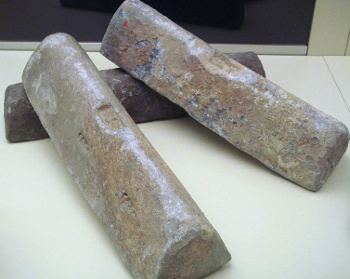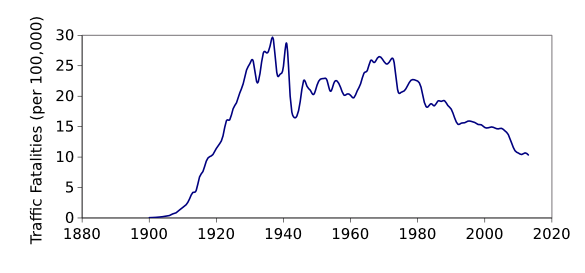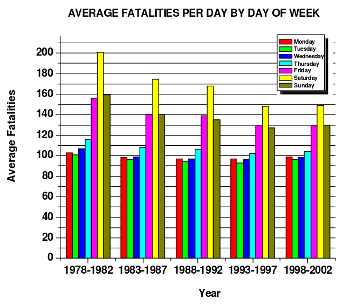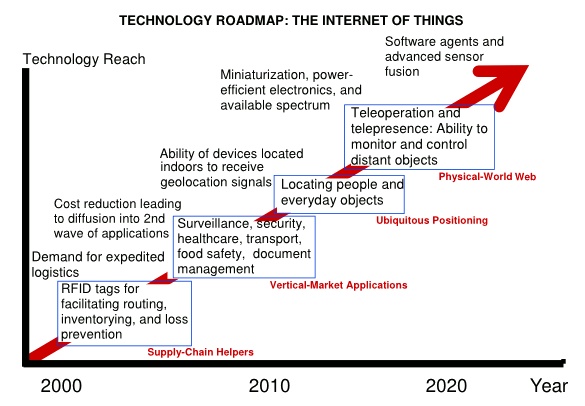Dangerous Technology
August 13, 2015
While
basic science is pursued for the
abstract reason of
curiosity, humans pursue
technology simply for the reason that it makes their lives easier and more pleasurable.
Spinning is easier than
hunting for obtaining
clothing material, and the resulting product is more
aesthetic.
Agriculture is an advance over
foraging, and
writing exceeds the human capacity for
memorization.
Metallurgy has been practiced for more than eight
millennia, and the
Romans mined silver and
lead extensively to make various
artifacts from
goblets to
pipes. Roman production of lead was about 80,000
tons per year at its peak. This leads us to the topic of this article, the
dangers of technology, including
unintended consequences.

Ingots of lead from the time of the Roman Empire.
(Exhibit at the Museum of Cádiz, via Wikimedia Commons.)
As we now know,
lead compounds are
toxic.[1] As I wrote in a
previous article (Antimicrobial Alloys, January 31, 2014), It's conjectured that one factor in the
fall of the Roman Empire was the use of lead containers in the production of
wine and the use of lead wine goblets by the
ruling class.
As someone who has
children, and now
grandchildren, I see that "
child-proofing" a
home is much harder today than several
decades ago, principally because of increased technology. In the past, you would just lock the
cabinet containing the usual assortment of
household chemicals under the
kitchen sink. These "household" chemical would include such harsh substances as
ammonium hydroxide ("ammonia"),
sodium hydroxide (lye), and
sodium hypochlorite (bleach).
Today, despite
wireless technologies, there are
cables everywhere, for things such as
chargers,
computer, and
television connection. A child can
chew on cables, get cables
wrapped around his neck, or pull on a cable to topple a heavy television set. From 2000 to 2011, 349 people in the US, including 293 children, were killed when televisions,
furniture, or
appliances toppled over onto them.[2]
One technology of the
modern age that's had a huge affect on our
lifestyle and
society is the
automobile. Nearly everyone drives, nearly every house has a
garage, and our
landscape is scarred by
highways. The automobile, and its
cousin, the
truck, has enabled
suburban living by allowing people and goods to travel farther than before. Of course, a technology capable of moving thousands of
kilograms of
mass at a hundred
kilometers per hour is a dangerous technology.
The number of
traffic fatalities in the
United States peaked at 52,627 in 1970, at which point a few
safety technologies, such as
seat belts,
air bags, and
advanced braking systems, became common equipment. The fatalities, although smaller in number, are still significant. An estimated 32,675 people died in
motor vehicle crashes in 2014,[3-4] and we can now add
cellphones, the facilitator of
distracted driving, to our list of dangerous technologies.

Motor vehicle fatalities from 1900 to the present. Data from the National Highway Traffic Safety Administration, graphed using Gnumeric. )
Surprisingly, the
calendar, through the invention of the
work week, has hidden dangers. More traffic accidents happen on
weekends, a trend that's persisted for three decades or more, as shown in the following graph.

Not safe on Saturday.
Traffic fatalities are more likely to happen on weekends.
(Fig. 10 from the National Highway Traffic Safety Administration report in ref. 5.[5]
Click for larger image)
Scientists are people, too (a good
slogan for a
bumper sticker?), and many of my
colleagues, all
sober individuals, have had traffic accidents. As a few examples, one hit a
deer on his
evening commute, another skid into a
utility pole, and yet another slid on
ice into the back of a
snow plow on our
research campus. I was hit while making a turn at an
intersection while on my way to a
seminar on
crystal growth. Yes, we suffer for our
science.
As I wrote In a
previous article (Unsafe at Any Speed, February 6, 2007), several famous scientists have been killed, or have had their lives changed, by an automobile accident. These include Lev Landau, Eugene (Gene) Shoemaker, Seymour Cray, Mary Ward, Rudolf Karl Luneburg, William Shockley, Arnold Sommerfeld, Max von Laue and John Schrieffer.
Recently, mathematician,
John Forbes Nash, Jr., who was awarded the 1994
Nobel Memorial Prize in Economic Sciences, and his
wife died in a May 23, 2015, automobile accident. Nash, who was the subject of the
book,
A Beautiful Mind by
Sylvia Nasar and the
subsequent film, was on the last leg of a trip to
Norway, where he was awarded the 2015
Abel Prize.
Not all traffic accidents can be blamed on
human error.
Automobiles are
complex machines having many
failure mechanisms. Recently, many
automobile manufacturers have been
fined for slow action on
safety recalls involving
fuel tanks that
ignite in
rear-end collisions,
ignition switches that turn off the
engine unexpectedly, and
floor mats that interfere with
control pedals.[6-8] Even safety systems can be dangerous, as a recent air bag recall shows.[9]
The technological complexity of automobiles is rapidly increasing through the incorporation of more
electronics and more control
software. Now that
hackers have conquered your
home computer, they're going after your car. Two
security researchers have illustrated that such a thing can happen by demonstrating a remote takeover of a
Jeep Cherokee.[10-12] They accomplished their attack by injecting code into a
digital audio broadcast received by the vehicle's
radio system.[10] The attack, which allowed killing the engine and remotely activating or disabling the
brakes, affects 1.4 million US vehicles. [11] A
YouTube video has been posted of the demonstration.[12]
According to the recently published book,
Future Crimes by
Marc Goodman (
Doubleday, February 24, 2015), after the hackers get your car, they'll go after your house and everything in it.[13] The enabling technology behind this new danger is the "
Internet of Things" (IoT) future in which nearly everything will be connected to the
Internet. I wrote about the IoT in a
previous article (The Internet of Things, October 11, 2013).

A technology roadmap for the Internet of Things, as prepared for the US government in 2008. (Wikimedia Commons image, modified for clarity. Click image for a larger version)
Just as hackers and other
nefarious organizations have been able to take control of desktop computers and
industrial control systems, they can control nearly everything connected to the Internet. The problem is that even carefully designed software often contains flaws that are easily exploited to grant a hacker complete system control. Things become especially worrisome when the software controls an
implanted medical device with wireless Internet connectivity designed for
health monitoring and control of the device
parameters.
Other elements of future technology with potential dangers are
nanotechnology,
biotechnology, and
robotics.
At least two people have been killed by
industrial robots. As the
reviewer of
Future Crimes in the
Pittsburgh Post-Gazette writes, technology proceeds at an
exponential pace, while our
analysis of the consequences of those technologies is just
incremental.[13] The
Internet meme, "
all your base are belong to us," is starting to acquire an expanded meaning.
References:
- Lead, United States Environmental Protection Agency Web Site.
- U.S. Consumer Product Safety Commission Press Release Number 13-066, December 13, 2012.
- Early Estimate of Motor Vehicle Traffic Fatalities in 2014, A Brief Statistical Summary, National Center for Statistics and Analysis, National Highway Traffic Safety Administration Report DOT HS 812 160, June, 2015 (PDF File)
- Anders Longthorne, Rajesh Subramanian, and Chou-Lin Chen, "An Analysis of the Significant Decline in Motor Vehicle Traffic Fatalities in 2008," National Center for Statistics and Analysis, National Highway Traffic Safety Administration Report DOT HS 811 346, June 2010 (PDF File).
- Cejun Liu Chou, Lin Chen, and Dennis Utter, "Trend and Pattern Analysis of Highway Crash Fatality By Month and Day," National Center for Statistics and Analysis, National Highway Traffic Safety Administration Report DOT HS 809 855, March 2005 (PDF File).
- Jeff Plungis, "NHTSA Says Fiat Chrysler to Pay $105 Million Fine, Buy Back Some Vehicles," Bloomberg News, July 26, 2015.
- Chris Woodyard, "Fiat Chrysler agrees to record $105M fine over safety," USA Today, July 26, 2015.
- Fiat Chrysler recalls 703,000 vehicles in U.S. to fix ignition switches, Reuters, March 7, 2015.
- Everything you need to know about the Takata airbag recall, Consumer Reports, July 16, 2015.
- Fiat Chrysler recalls 1.4 million cars after Jeep hack, BBC News, July 24, 2015.
- Aaron Souppouris, "Fiat Chrysler recalls 1.4 million vehicles after remote hack," Engadget, July 24, 2015.
- Hackers Remotely Kill a Jeep on the Highway—With Me in It, YouTube Video by Wired, July 21, 2015.
- Rich Lord, "Book Review - 'Future Crimes': A sober warning about the Internet of Things," Pittsburgh Post-Gazette, July 26, 2015.
Permanent Link to this article
Linked Keywords: Basic research; abstract; curiosity; technology; spinning; hunting; clothing; material; aesthetic; agriculture; foraging; writing; memorization; metallurgy; millennia; Roman Empire; Romans; mining; silver; lead; artifact; goblet; pipe; ton; hazard; danger; unintended consequences; ingot; Museum of Cádiz; Wikimedia Commons; lead compound; toxicity; toxic; fall of the Roman Empire; wine; ruling class; child; children; grandchild; grandchildren; child-proofing; home; decade; cabinet; household chemical; kitchen; sink; ammonium hydroxide; sodium hydroxide; sodium hypochlorite; wireless network; cable; battery charger; desktop computer; television; mastication; chew; strangling; furniture; appliance; modern age; lifestyle; society; automobile; garage; landscape; highway; cousin; truck; suburb; suburban; kilogram; mass; kilometers per hour; traffic collision; traffic fatalities; United States; safety; seat belt; air bag; anti-lock braking system; advanced braking system; motor vehicle crashes; mobile phone; cellphone; distracted driving; National Highway Traffic Safety Administration; Gnumeric; calendar; work week; weekend; Saturday; scientist; slogan; bumper sticker; colleague; sobriety; sober; deer; evening; commuting; commute; utility pole; ice; snow plow; research; campus; intersection; seminar; crystal growth; science; Lev Landau; Eugene (Gene) Shoemaker; Seymour Cray; Mary Ward; Rudolf Karl Luneburg; William Shockley; Arnold Sommerfeld; Max von Laue; John Schrieffer; mathematician; John Forbes Nash, Jr.; Nobel Memorial Prize in Economic Sciences; wife; book; A Beautiful Mind; Sylvia Nasar; film; Norway; Abel Prize; human error; car; automobile; complexity; complex; machines; failure mechanism; automotive industry; automobile manufacturer; fine; safety recall; fuel tank; combustion; ignite; rear-end collision; ignition switch; engine; floor mat; automobile pedal; control pedal; electronics; software; computer security hacker; home computer; security; research; researcher; Jeep Cherokee; digital audio broadcast; radio; vehicle brake; YouTube video; Future Crimes; Marc Goodman; Doubleday; Internet of Things; Internet; Technology Roadmap for the Internet of Things; technology roadmap; nefarious; industrial control system; implant; medical device; health; parameter; nanotechnology; biotechnology; robotics; Deaths caused by industrial robots; industrial robots; book review; Pittsburgh Post-Gazette; exponential function; analysis; incremental; Internet meme; all your base are belong to us.